Kenya’s Sometimes-Clashing Tribes Find Common Ground at Slum Restaurants
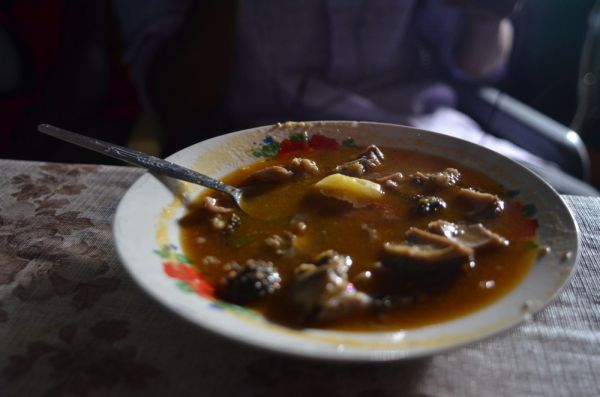
A bowl of matumbo at Thomson Falls Hotel. Photo credit: Jason Patinkin
The best meal I’ve had in Nairobi’s informal settlements was at an unmarked restaurant behind a hole in a sheet-metal fence in Kibera.
“It’s a bit hidden,” said Godwin, a university student who took me on a culinary tour through Nairobi’s slums. “So it’s only for people that know that place who go there.” Those that know will find a Nubian grandma named Mama Ntilie sitting on a wooden stool in the middle of her kitchen, flipping chapatis, ordering her staff around and serving up a mean beef pilau.
Godwin could tell the quality of Mama Ntilie’s pilau just by spooning the dish. “The meat is mixed in the rice,” he said. “And see how the rice falls apart and doesn’t stick together? That is very nice.” The rice was browned with a blend of spices including ginger, peppercorns, cardamom and anise. In the mix were diced pearl onions, and the beef was juicy and tender with the slightest crispiness. Coarsely cut tomatoes and cabbage topped the dish, with a hot chili paste on the side. To finish, we drank a clear tea of ginger, lemon and cinnamon.
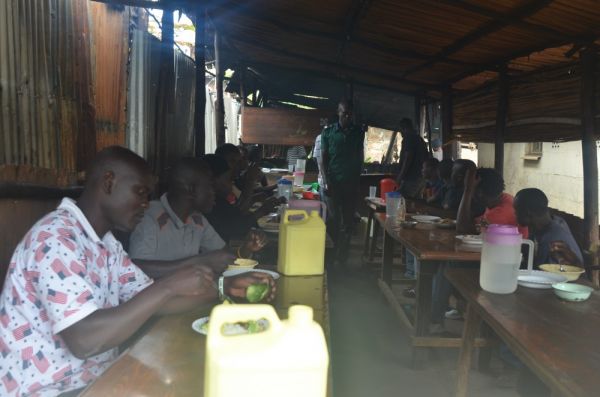
Diners at Mama Nitlie’s restaurant. Photo credit: Jason Patinkin
Pilau is Swahili food, brought from Kenya’s predominately Muslim coast where African, Indian and Arab traders mixed culture and cuisine for centuries. These days, the cultural exchange takes place not in coastal port cities but in Nairobi’s slums, where job-seeking migrants from across Kenya settle with their languages, customs and food. Mama Ntilie’s Muslim Nubians were given Kibera a century ago by the British, but since then they’ve been forced to share the land with dozens of other ethnicities. Places like Kibera are known for real and imagined ethnic tensions during election years, but the rest of the time they are places where many from Kenya’s 42 tribes sit at restaurants elbow-to-elbow to enjoy a square meal.
One such restaurant is Abondo’s in Kibera. Abondo’s is the type of joint found in blue-collar towns anywhere. Waiters sling bowls of hot soup from a steamy kitchen window while an assembly line of cooks kneads, rolls and grills chapati, a wheat-flour flatbread. Abondo’s opens at 5 a.m. and the stoves stay hot until ten at night to feed the stream of hungry workers. Godwin and I visited in the lull between breakfast and lunch. “One thing I like about this place is they got a variety of food,” he said. But we stuck to the basics: milky tea, chapati, beef stew and, of course, ugali.
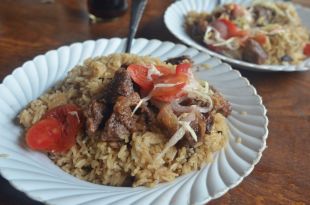
The excellent pilau at Mama Nitlie’s. Photo credit: Jason Patinkin
Ugali is Kenya’s staple starch, a white paste of maize meal paired with nearly every dish to extend flavor and fill the belly. To eat ugali, you pinch off a small chunk and hold it in your palm, squeezing and rotating until it is uniformly dense and flexible, the consistency of fresh play-doh. Then it can be dunked in sauce or used to scoop up solids. Though flavorless, ugali’s quality varies. If cooked well, it doesn’t need much squeezing, and crumbs don’t stick to your hand. At Abondo’s the ugali was ideal.
The rest of the meal was underwhelming. Abondo’s owner said he sells over 1,400 chapati a day, but ours were cold, leftovers from breakfast while the cooks restocked for lunch, and the beef stew was plain—tough cubes of meat in tomato and onion sauce. But flavor isn’t the priority at Abondo’s. “They serve food in plenty and it is cheap,” said Godwin. “And they have good service.” The whole meal for two cost 200 shillings (about $2.50 USD) and we waited no more than five minutes for our food. Switch the ugali, chapati and stew for eggs, toast and bacon, and Abondo’s is a Rust Belt diner. Two line cooks make chapati outside of Abondo’s. Photo credit: Jason Patinkin
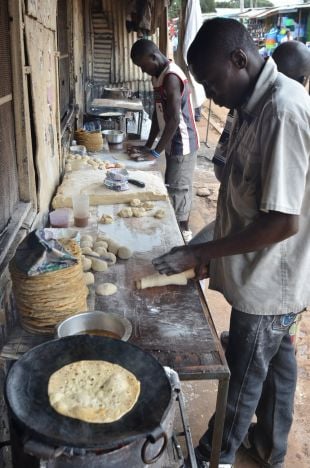
Across town in Mathare slum, we found the same good service and price with better flavor at the extravagantly named Thomson Falls Hotel. Barely fifteen people squeezed into the sweltering windowless shack where customers competed with cooks for elbow room. But Fred Njoroge, a friend of mine from the neighborhood, said there’s no better spot around to eat. “This place is high class,” he said. “If you don’t see them cooking then the food could come from anywhere.”
I ordered chapati and ndengu, a thick porridge of green grams, also called mung beans, that was reminiscent of a hearty lentil soup. The chapati was hot and crispy, not the usual soft variety, and the extra crunch made it ideal for dipping in ndengu. But Njoroge said Thomson Falls Hotel is best known for matumbo, a tripe soup. “It has stomach, small intestine and large intestine, and they clean it well,” he said, pleased as he inspected the lining on a hunk of cow stomach in his bowl. “You can see no grass in there.”
I tried a bite of matumbo—I think small intestine—but the flavor was too strong for me, the type of thing you have to grow up with to appreciate. Indeed, matumbo is a dish borne of necessity as finer cuts of meat are too expensive. At Thomson Falls Hotel, a bowl of matumbo cost only forty shillings, about fifty cents, less than half the cost of a bowl of Mama Ntilie’s pilau.
There are other proteins to eat in informal settlements, like githeri, a mix of beans and maize, and blood sausage, which was rich and excellent with a pinch of salt, and less tasty chicken entrails stuffed with boiled potato. Godwin and I found a chef from Lake Victoria who served lightly fried tilapia in a broth with onion and tomato. With so many cultures living side by side in Nairobi’s slums, the food options are plenty.
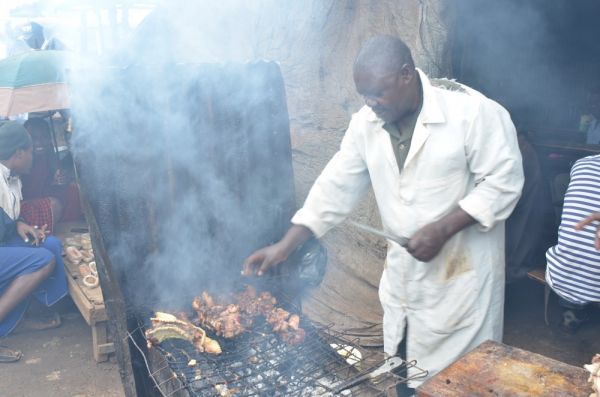
John Wanyama, a.k.a. “The Meat Man.” Photo credit: Jason Patinkin
But there’s one dish enjoyed by all Kenyans, grilled goat and beef called nyama choma. In upscale establishments, diners gnaw on fatty steaks washed down with bottled beer. In Kibera, Godwin took me to a sprawl of wooden shacks where men drank a home-brewed fermented porridge called busaa by smoky grills serving seared organ meats. At one grill was John Wanyama, dressed in a white butcher’s apron. Wanyama’s name roughly translates in Swahili to “many meats,” or as he put it, “The Meat Man.” He pulled cow tongues and guts from a bucket and slapped them on the coals, cutting off bite-sized chunks with a long knife and sprinkling salt on them before serving.
Godwin and I tried thin slices of boiled tongue and generous cuts of grilled cow heart. The tongue was tough, but the heart was delicious—crispy and juicy, coated in a layer of melting yellow fat. We chewed the meat and watched the men take their busaa. “When you have a drink, you want to eat some meat,” Godwin observed. All of us standing by the grill nodded in agreement at such universal words. Then the Meat Man tossed another cow tongue on the fire.









